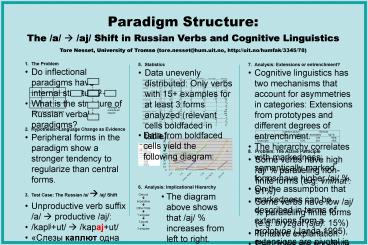Paradigm Structure: PowerPoint PPT Presentation
1 / 1
Title: Paradigm Structure:
1
Paradigm Structure The /a/ ? /aj/ Shift in
Russian Verbs and Cognitive Linguistics Tore
Nesset, University of Tromsø (tore.nesset_at_hum.uit.
no, http//uit.no/humfak/3345/78)
- 1. The Problem
- Do inflectional paradigms have internal
structure? - What is the structure of Russian verbal paradigms?
- 5. Statistics
- Data unevenly distributed Only verbs with 15
examples for at least 3 forms analyzed (relevant
cells boldfaced in table).
- 7. Analysis Extensions or entrenchment?
- Cognitive linguistics has two mechanisms that
account for asymmetries in categories Extensions
from prototypes and different degrees of
entrenchment. - The hierarchy correlates with markedness
semantically marked forms have higher /aj/ . - On the assumption that markedness can be
described in terms of extensions from a prototype
(Janda 1995), extensions are pivotal in the
structure of Russian verb paradigms. - What is the role of entrenchment (frequency)?
- Test case Verbs with high frequency non-finite
forms and low frequency finite forms. Does /aj/
correlate with frequency or markedness? - The table below shows no correlation with
frequency, thus suggesting that extensions are
more important than frequency for the structure
of Russian verb paradigms.
Paradigm as a structured network
Paradigm as an unstructured list
- 2. Hypothesis Language Change as Evidence
- Peripheral forms in the paradigm show a stronger
tendency to regularize than central forms. - Test Case The Russian /a/ ? /aj/ Shift
- Unproductive verb suffix /a/ ? productive /aj/
- /kapljut/ ? /kapajut/
- ????? ?????? ???? ?? ?????? ?? ???????.
- (Goncarov 1859 with /a/ suffix)
- ????? ? ?? ??????. (Bitov 1969 with /aj/
suffix) - Ideal test case
- Well documented (e.g. Krysin 1974, Andersen 1980)
- Searchable in electronic corpora
- Russian verbs have large paradigms with
potentially complex structure. - 4. My Database
- Investigated 30 verbs where suffix shift is
expected. - Only non-prefixed verbs examined so far.
- Data from The Russian National Corpus
- Balanced corpus of 120 million words
- Searchable on the internet (http//ruscorpora.ru)
- My database contains 12,000 examples.
- Data from boldfaced cells yield the following
diagram
- Problem The Active Participle
- Some verbs have high /aj/ paralleling
non-finite forms (e.g. vnimat 81) - Some verbs have low /aj/ paralleling finite
forms (e.g. bryzgat(sja) 15) - Tentative explanation
- Participles are non-finite forms for which we
expect high /aj/ . - Formally, the active participle is closely
related to finite forms, for which low /aj/ is
expected. - Diverse behavior may be due to these conflicting
forces. - 9. Conclusions
- Suffix shift is compatible with implicational
hierarchy - ? Russian verb paradigms have internal structure.
- Hierarchy correlates with semantic markedness
- ? Extension relations are more important than
entrenchment. - 10. Further questions
- Does prefixation influence the /a/ ? /aj/ shift?
- Does the postfix -sja influence the /a/ ? /aj/
shift? - Does polysemy influence the /a/ ? /aj/ shift?
6. Analysis Implicational Hierarchy
- The diagram above shows that /aj/ increases
from left to right. - The /a//aj/ variation is compatible with an
implicational hierarchy (left). - The hierarchy
- confirms the hypothesis about regularization in
peripheral forms (cf. Section 2). - suggests that Russian verb paradigms have
internal structure.
Gerund ? Imperative ? Other finite ? 1
singular ? 3 plural ? 3 singular

